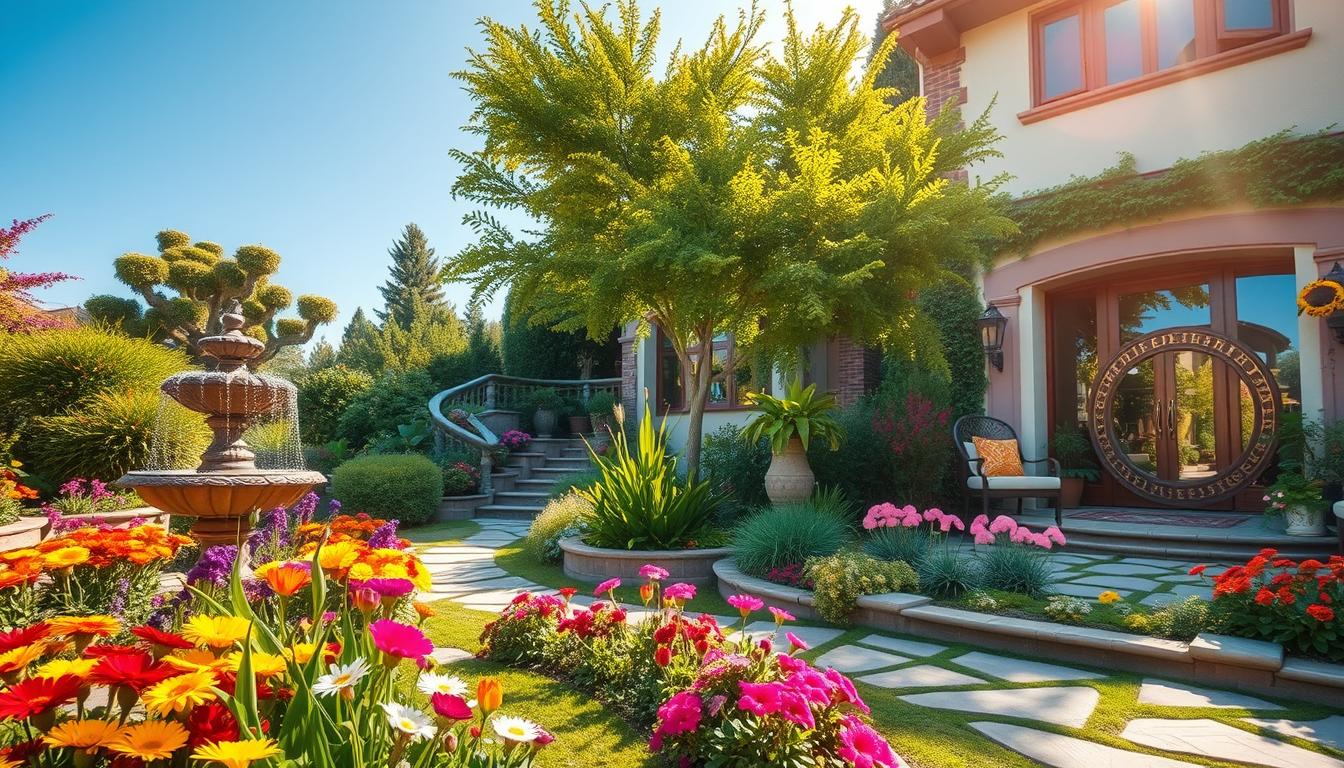I’m thrilled to share my love for Garden Design and Landscaping. It’s helped me make beautiful outdoor spaces that are both pretty and useful. I’ve found that using sustainable landscaping makes yards look even better.
In this article, we’ll explore many Garden Design and Landscaping topics. We’ll talk about making welcoming outdoor areas and the perks of eco-friendly landscaping. My aim is to give you useful tips and knowledge to make your yard amazing.
Understanding Garden Design Basics
Creating a beautiful outdoor space starts with garden planning. A well-designed garden turns your backyard into a peaceful oasis. It’s perfect for relaxing and having fun. Landscape architecture is key, as it plans and arranges elements for a beautiful space.
Planning is vital for a successful backyard makeover. You need to know your yard’s climate, soil, and sunlight. This way, your garden will look great and grow well.
The Importance of Planning
Good garden planning considers looks and function. You might want areas for fun, rest, or gardening. By focusing on your needs, you’ll get a garden that fits your life.
Essential Elements of Garden Design
Key garden design elements include:
- Color and texture for depth and interest
- Lighting for ambiance and safety
- Water features for peace and calm
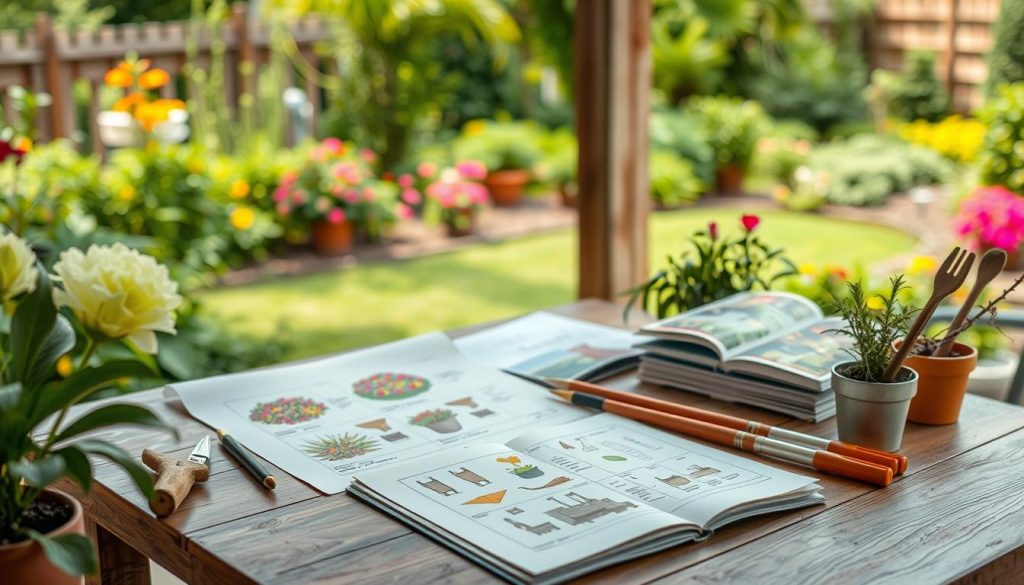
Common Mistakes to Avoid
Don’t make these garden design mistakes. Ignore the climate and soil, or leave no room for growth. Also, forget about lighting and water features. Knowing these errors helps you create a beautiful, functional garden.
Choosing the Right Plants for Your Space
Creating a beautiful garden starts with picking the right plants. A well-designed flower garden can greatly enhance your outdoor space. It’s important to think about climate zones, native plants, and seasonal selection.
Understanding Climate Zones
Climate zones are key in choosing plants for your garden. Knowing your local climate zone helps pick plants that grow well there. This also means less work for lawn care and supports green gardening.
Native Plants to Consider
Native plants are great for gardens because they fit the local climate well. They need less care and help save water and reduce harmful chemicals. Examples include wildflowers, shrubs, and trees native to your area.
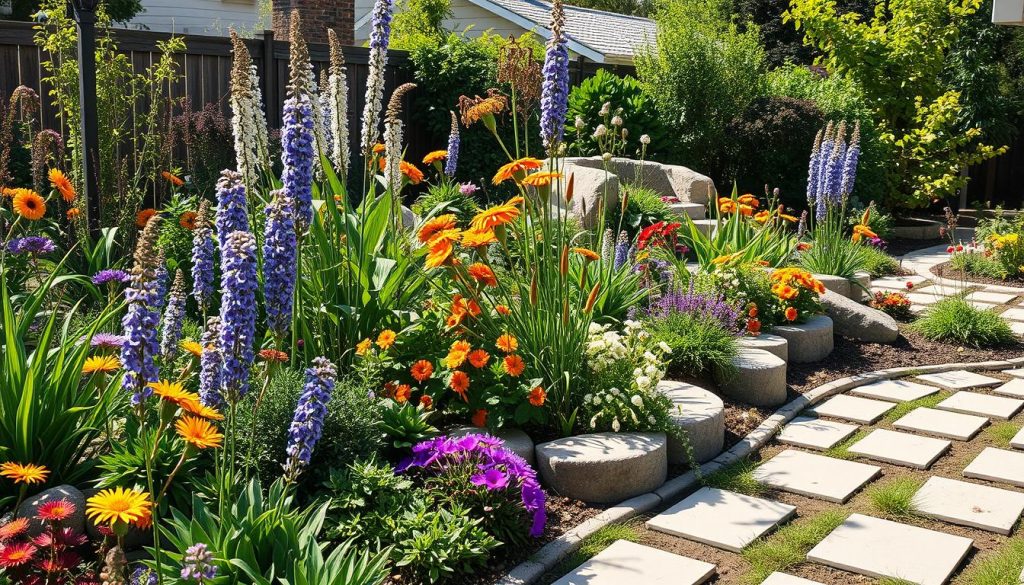
Seasonal Plant Selection
Choosing plants for each season is vital for a lively garden. This way, your garden stays colorful all year. It also keeps your landscape balanced and eco-friendly, needing less lawn care.
Designing for Different Spaces and Styles
Designing outdoor living spaces requires understanding your yard’s unique features. Whether it’s a small urban garden or a large rural area, the right design matters. Hardscaping, like patios and walkways, can help organize your yard and improve flow.
In urban gardens, space is limited. Use vertical elements like trellises and arbors. Garden lighting design adds ambiance and highlights important features. Rural gardens, with more space, can have bigger hardscaping and outdoor areas.
Urban Gardens vs. Rural Gardens
- Urban gardens: focus on vertical elements, compact hardscaping, and strategic garden lighting design
- Rural gardens: often feature more expansive hardscaping, larger outdoor living spaces, and a greater emphasis on natural elements
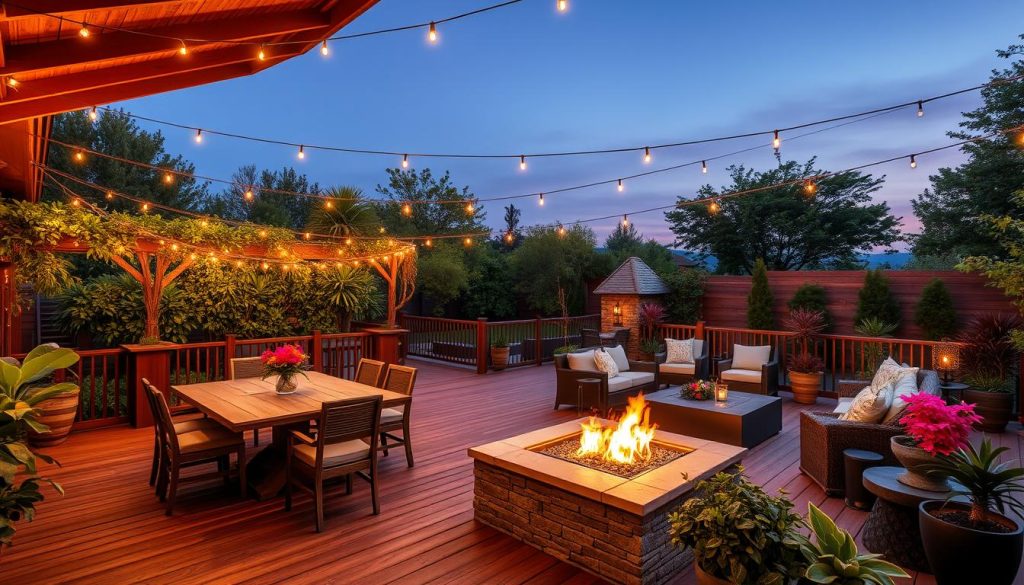
Formal vs. Informal Layouts
Choosing the right garden style is crucial. Formal gardens have symmetrical designs and straight lines. Informal gardens are more relaxed, with curves and varied plants. Selecting a style that fits your yard creates a beautiful and functional space that shows your taste.
Creating Functional Outdoor Spaces
A well-designed outdoor area can greatly enhance your living space. A backyard makeover can be achieved through smart landscape architecture. This ensures the space meets the needs of the homeowner and their family.
Designing for Entertaining
Creating outdoor spaces for entertaining is both fun and creative. Think about the flow of traffic, seating, and outdoor kitchens or bars. This will help you design a perfect spot for gatherings.
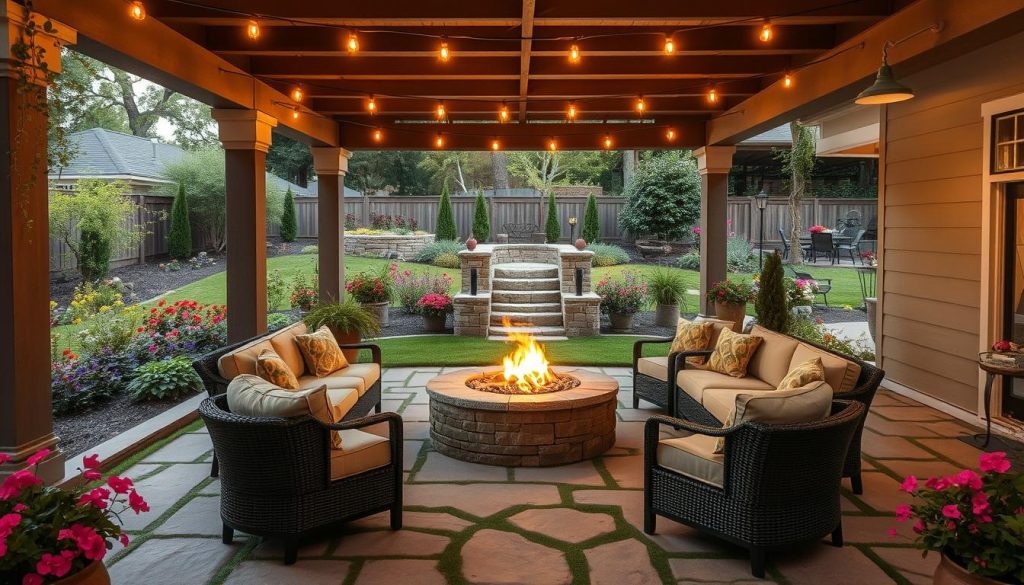
Relaxation Zones: Patios and Seating
Patios and seating areas are key for a peaceful outdoor space. Use comfy outdoor furniture and add plants or water features. These elements help create a calming atmosphere.
Pathways and Flow
Pathways and flow are vital for a functional outdoor space. Use landscape architecture to guide visitors and enhance the space’s flow. Walkways, stairs, and other design elements can connect different yard areas.
Maximizing Small Yards
Every inch matters in small yards. Homeowners aim to use their outdoor space wisely. Sustainable landscaping, garden planning, and lawn maintenance services help achieve this goal.
Vertical gardening is a great way to use space. Trellises, arbors, and wall-mounted planters add greenery without taking up much room. Container gardening also brings color and texture, using large pots or planters as focal points.
Multi-Functional Features
Incorporating multi-functional features is key. A bench can serve as a planter, and a small patio can be a seating area. Lawn maintenance keeps your yard looking great, making it inviting.
Some popular features for small yards include:
- Outdoor kitchens or dining areas
- Fire pits or outdoor fireplaces
- Seating areas or conversation circles
By adding these features and using sustainable landscaping, small yards can be both beautiful and functional. Remember to plan your garden and lawn maintenance carefully. Don’t hesitate to think creatively to maximize your space.
| Feature | Benefits |
|---|---|
| Vertical Gardening | Maximizes space, adds greenery |
| Container Gardening | Adds color and texture, easy to maintain |
| Multi-Functional Features | Creates a functional and inviting outdoor space |
Sustainability in Gardening and Landscaping
I’m excited to share my garden design and landscaping secrets. Sustainability in gardening and landscaping is key. It’s not just good for the planet, but it also makes outdoor spaces beautiful and useful. When planning your garden, pick eco-friendly plants that need less water and care.
Eco-Friendly Plant Choices
Consider using succulents, native plants, and drought-resistant grasses. These are great for sustainable landscaping. They can thrive with little care in outdoor spaces.
Water Conservation Techniques
To save water, think about using rain barrels and drip irrigation systems. Mulch can also help by reducing evaporation. These methods help create a water-saving garden that’s good for the planet.
Composting for Healthier Soil
Composting is vital for sustainable landscaping. It turns food waste and yard trimmings into nutrient-rich soil. This supports plant growth and cuts down on fertilizer use. It’s a smart way to make your garden healthy and sustainable.
By using these sustainable practices, you can make a lovely outdoor space. It will not only improve your home but also help the environment.
| Sustainable Landscaping Tips | Benefits |
|---|---|
| Eco-friendly plant choices | Reduced water consumption, minimal maintenance |
| Water conservation techniques | Conserves water, reduces environmental footprint |
| Composting | Creates healthier soil, reduces need for fertilizers |
Hardscaping: The Art of Non-Plant Elements
Hardscaping is key in making outdoor spaces both beautiful and useful. It uses materials like stones, bricks, and concrete to add structures and features. These elements enhance the look and function of the area.
Choosing the Right Materials
There are many materials for hardscaping, each with its own look and feel. Natural stone, brick, and concrete pavers are popular choices. It’s important to think about durability, upkeep, and cost when picking materials.
Fencing and Privacy Solutions
Fences and privacy solutions are vital for hardscaping. They help shape the outdoor space and offer privacy. Options range from wooden fences to metal railings, fitting various styles and budgets. The fence should match the landscape’s overall look.
Steps, Patios, and Decking
Steps, patios, and decking are essential for hardscaping. They make outdoor living areas functional and cozy. When designing, consider the space’s flow, materials, and look. These elements can turn a simple space into a beautiful, functional area.
Enhancing Your Garden with Lighting
When designing outdoor spaces, garden lighting is key to a welcoming feel. The right lighting can transform a garden, making it inviting. In landscape design, lights are used to showcase features, add depth, and guide visitors.
Types of Garden Lighting
There are many garden lighting options, like solar lights, string lights, and spotlights. Each has its own benefits. Solar lights are green and simple to set up. String lights bring a playful vibe to gardens.
Placement Strategies for Impact
Strategic lighting placement is crucial for a stunning effect. Here are some tips:
- Highlight specific features, such as water features or statues
- Create a sense of depth by layering lights
- Use lights to guide visitors through the space
Safety Considerations
Safety is a top priority in garden lighting design. Make sure lights are securely fixed and wires are out of sight. By following these guidelines, you can create a beautiful, safe garden for relaxation and fun.
| Lighting Type | Characteristics | Uses |
|---|---|---|
| Solar-Powered Lights | Energy-Efficient, Easy to Install | Pathways, Gardens |
| String Lights | Whimsical, Ambient | Pergolas, Patios |
| Spotlights | Directional, Focused | Highlighting Features |
Seasonal Maintenance Tips
To keep your garden looking great all year, following seasonal maintenance tips is key. Lawn maintenance services are vital for a healthy lawn. Garden planning and sustainable landscaping help create a space that’s easy to care for.
In spring, getting ready and planting is important. This is the best time to check your garden and make changes. Lawn maintenance services can help with pruning, fertilizing, and pest control. This way, you’ll have a lush garden all season.
Spring Preparation and Planting
- Assess your garden’s condition and make any necessary adjustments
- Hire lawn maintenance services to help with tasks such as pruning, fertilizing, and pest control
- Plant new flowers, trees, and shrubs to add color and texture to your garden
In summer, taking good care of your garden is crucial. This includes watering, mowing, and fertilizing regularly. Using sustainable landscaping, like drought-resistant plants, makes your garden beautiful and eco-friendly.
Summer Care Techniques
- Water your plants regularly, but avoid overwatering
- Mow your lawn regularly to maintain a healthy height
- Fertilize your plants to promote healthy growth
In fall, cleaning up is key to get your garden ready for winter. Remove dead plants, leaves, and debris. Apply mulch to protect your soil. These tips help keep your garden looking great all year.
Incorporating Wildlife in Garden Design
As I share my garden secrets, I stress the value of adding wildlife to your outdoor spaces. This makes your yard more beautiful and helps the environment. By welcoming birds, butterflies, and bees, you support pollination and a healthy ecosystem.
When planning your garden, think about what plants and features attract wildlife. Native plants, shrubs, and trees offer food and shelter. Water features like birdbaths or ponds draw birds and other creatures. This creates a vibrant ecosystem that boosts biodiversity and beautifies your outdoor areas.
Here are some tips for adding wildlife to your garden:
- Plant native flowers, shrubs, and trees for bees and butterflies.
- Install a birdbath or pond to attract birds and other wildlife.
- Create a bee-friendly area by avoiding pesticides and providing water.
By using these tips and focusing on sustainable landscaping, you can make a stunning garden. It will support local wildlife and improve your outdoor living spaces. Always plan your garden with wildlife in mind, choosing plants and features that attract them.
| Wildlife-Friendly Features | Benefits |
|---|---|
| Native Plants | Provide food and shelter for wildlife |
| Birdbaths and Ponds | Attract birds and other wildlife |
| Bee-Friendly Spaces | Support pollination and local biodiversity |
Personalizing Your Garden Design
Thinking about my garden design and landscaping journey, I see how key it is to make outdoor spaces personal. It’s not just about beauty; it’s about function and meaning. Adding personal art and decor makes your garden truly yours.
Personalizing your garden involves several steps. Here are some tips to begin:
- Choose plants, colors, and materials that speak to you.
- Use personal art and decor, like sculptures or murals, for a unique touch.
- Include sustainable touches, like rain barrels or compost bins, to help the environment.
By making your garden personal, you create a space that shows your personality. It should be a place of comfort and relaxation. Whether for entertaining or quiet time, your garden should reflect your style and preferences. With creativity and planning, your garden can become a beautiful oasis that improves your life.
| Personalization Ideas | Benefits |
|---|---|
| Reflecting personality through design | Creates a sense of ownership and connection to the space |
| Using personal art and decor | Adds a unique touch and visual interest to the garden |
| Incorporating sustainable touches | Reduces environmental footprint and promotes eco-friendliness |
Resources for Further Learning
Exploring garden design and landscaping is exciting. It’s key to have good resources and inspiration. Whether you want to make beautiful outdoor spaces or focus on green gardening, many tools can help you.
Gardening Books to Inspire You
There are many books on garden design and landscaping. You can find guides and books on sustainable gardening. Experts and special publications offer great advice.
Online Communities and Forums
Online communities and forums are great for connecting with garden lovers. You can ask questions and share your experiences. Websites and social media groups are full of garden design and landscaping tips.
Local Gardening Clubs and Workshops
Local gardening clubs and workshops are excellent for learning. You can meet experienced gardeners and try different techniques. These events often talk about sustainable landscaping and garden design, offering useful tips.
I’m excited to share my expertise in Garden Design and Landscaping. I want to help you create a stunning outdoor space. As a passionate gardener, I believe your outdoor space should be both functional and beautiful.
I always incorporate sustainable landscaping practices into my designs. This way, your outdoor space can be both good for the environment and enjoyable for you.
By focusing on Garden Design and Landscaping, homeowners can reduce their environmental impact. They can also create a space that meets their needs. Whether you’re looking to entertain or relax, your outdoor space can be designed to provide a functional and enjoyable area for everyone.
In this article, I’ll share my personal experience and expertise in Garden Design and Landscaping. I’ll give you tips on sustainable landscaping and creating beautiful outdoor living spaces. By the end of this journey, you’ll have the knowledge to unlock the beauty of your yard and create a space you’ll love spending time in.
Understanding Garden Design Basics
Creating a beautiful outdoor space starts with garden planning. A well-designed garden can make your property look better and offer a peaceful escape. By using landscape architecture and thinking about backyard transformation, you can make a unique and stunning outdoor area that fits your needs and style.
Planning is key to start. You need to decide what your garden is for, check your climate and soil, and pick the right plants and materials. Important garden design elements include:
- Balance and proportion
- Color and texture
- Lighting and drainage
Don’t make common mistakes like ignoring the climate and soil, picking the wrong plants, or missing drainage and lighting. By avoiding these errors and focusing on garden planning, landscape architecture, and backyard transformation, you can create a beautiful and useful outdoor space. This space will be a joy to enjoy for many years.
| Garden Design Element | Importance |
|---|---|
| Balance and proportion | Creates a visually appealing space |
| Color and texture | Adds depth and interest to the garden |
| Lighting and drainage | Ensures the garden is functional and safe |
Choosing the Right Plants for Your Space
Choosing the right plants is key to a beautiful garden. A well-designed flower garden adds color and vibrancy to your outdoor space. It’s important to pick plants that fit your local climate.
Lawn maintenance services help keep your garden looking great. Sustainable landscaping is also gaining popularity. It focuses on using plants that are native and fit the climate well.
Here are some tips for picking the right plants:
- Research the local climate and choose plants that can handle drought or extreme weather.
- Think about how much sunlight and shade your garden gets. Pick plants that do well in those conditions.
- Go for plants that are native to your area and match your soil type.
By following these tips and using sustainable landscaping, you can have a beautiful garden that’s easy to care for.
Designing for Different Spaces and Styles
Designing outdoor living spaces needs careful thought about your yard’s unique features. Your design should match your style and needs. Urban gardens use space creatively, while rural ones are more open and natural.
Urban Gardens vs. Rural Gardens
In cities, hardscaping helps create a private area. This includes patios, walkways, and walls. Rural gardens, however, blend with nature, using native plants and natural materials.
Formal vs. Informal Layouts
Formal gardens have straight lines and symmetrical plants. Informal ones are more free and natural, with curves and varied plants. Lighting can make either style more inviting, with formal areas needing structured lights and informal ones softer lights.
Adding color and texture makes your garden beautiful and welcoming. Mix plants with different blooms and textures for depth. With good planning, your outdoor space will show your style and meet your needs.
To sum up, designing your outdoor space means thinking about your yard and what you like. Use hardscaping, lighting, and color to make a space that’s both lovely and useful. This will improve your life greatly.
| Design Style | Characteristics |
|---|---|
| Urban Gardens | Creative use of space, hardscaping, and urban materials |
| Rural Gardens | Natural materials, native plants, and expansive layouts |
| Formal Layouts | Straight lines, symmetrical patterns, and structured lighting |
| Informal Layouts | Curved lines, natural materials, and whimsical lighting |
Creating Functional Outdoor Spaces
Outdoor living spaces need to be functional. A well-designed area can offer years of fun, relaxation, and enjoyment for the family. By using landscape architecture, you can make a unique and beautiful outdoor space that meets your needs.
Transforming your backyard starts with planning and design. Think about how you want to use your outdoor area. Do you want to host dinner parties or have a peaceful spot? Knowing your needs helps you design a space that’s both useful and lovely.
Designing for Entertaining
For entertaining, think about the space’s flow. You need a path for guests, with seating and areas for gathering. Adding an outdoor kitchen or bar can also enhance your space.
Relaxation Zones: Patios and Seating
Relaxation zones are key in any outdoor area. Add a patio or seating area with lush plants and comfy furniture. It’s perfect for unwinding and enjoying the air.
Pathways and Flow
Don’t forget about pathways and flow. You want a natural path for visitors, with beauty and interest along the way. Landscape architecture can make your outdoor space stunning and functional, enjoyed for years.
| Outdoor Space | Functionality | Design Elements |
|---|---|---|
| Entertaining Area | Hosting dinner parties | Outdoor kitchen, bar, seating |
| Relaxation Zone | Unwinding and relaxing | Patio, seating, plants |
| Pathways and Flow | Creating a natural path | Landscape architecture, visual interest |
Maximizing Small Yards
Designing small yards can be a challenge. But with creativity and planning, even tiny spaces can become beautiful. Sustainable landscaping helps reduce environmental impact while achieving design goals.
Garden planning is key for small yards. It’s about creating a space that looks good and works well. Using vertical gardening and container gardening can make a big difference.
Vertical Gardening Techniques
Vertical gardening is great for small yards. It maximizes space. Here are some techniques:
- Using trellises or arbors to support climbing plants
- Installing wall-mounted planters or shelves
- Creating a living wall using a trellis or other support system
Container Gardening Ideas
Container gardening adds interest to small yards. Here are some ideas:
- Using large planters or pots to create a sense of scale
- Grouping smaller planters or pots together to create a sense of texture and interest
- Using hanging baskets or planters to add visual interest and create a sense of depth
By using sustainable landscaping, like lawn maintenance, homeowners can create a beautiful space. Even the smallest yards can become stunning outdoor oases with a little creativity.
| Technique | Description |
|---|---|
| Vertical Gardening | Using trellises, arbors, or wall-mounted planters to make the most of available space |
| Container Gardening | Using large or small planters, pots, or hanging baskets to add visual interest and create depth |
| Sustainable Landscaping | Practices that reduce environmental impact, such as lawn maintenance services and eco-friendly plant choices |
Sustainability in Gardening and Landscaping
Exploring gardening and landscaping shows us how vital sustainability is. Using sustainable landscaping can lessen our garden’s environmental footprint. Garden planning is key to this effort. By choosing eco-friendly plants, saving water, and composting, we can make our gardens green and healthy.
There are several important things to think about in sustainable landscaping. These include:
- Eco-friendly plant choices, such as native plants and drought-resistant species
- Water conservation techniques, such as rainwater harvesting and efficient irrigation systems
- Composting for healthier soil, which can reduce the need for fertilizers and pesticides
By adding these sustainable practices to our garden plans, we can make outdoor spaces that are both lovely and good for the planet. Sustainable landscaping is crucial for anyone wanting a functional and fun outdoor area.
| Benefit | Description |
|---|---|
| Reduced environmental impact | Sustainable landscaping practices can reduce the environmental impact of the garden, including water consumption and waste generation. |
| Cost savings | Sustainable landscaping practices, such as rainwater harvesting and composting, can also save homeowners money on water and fertilizer costs. |
| Increased property value | A well-designed and sustainable garden can increase the value of a property, making it more attractive to potential buyers. |
By using sustainable landscaping in our garden plans, we can create spaces that are both stunning and eco-friendly. Whether we want to lessen our environmental impact, save money, or boost our property’s value, sustainable landscaping is a must-consider for homeowners.
Hardscaping: The Art of Non-Plant Elements
Hardscaping is key in landscape design. It uses non-plant elements to make outdoor spaces both functional and beautiful. The right materials are crucial for the look and feel you want.
Choosing the Right Materials
Popular hardscaping materials include stone, brick, and concrete. Each has its own look, durability, and upkeep needs. For instance, stone is great for patios and walkways. Brick works well for walls and fences.
Fencing and Privacy Solutions
Fences and privacy solutions are vital in hardscaping. They offer security and seclusion. There are many types, like wooden, metal, and vinyl, each with its own pros and cons. Think about durability, upkeep, and style when picking a fence.
Steps, Patios, and Decking
Steps, patios, and decking are important in hardscaping. They make outdoor spaces functional and comfy. Consider the land’s slope and terrain, and what you want in terms of accessibility. For example, a patio is perfect for dining outside, while a deck is great for relaxing.
Adding hardscaping to your landscape design can create a unique and beautiful outdoor space. Whether you want a functional patio or a cozy deck, hardscaping can help you get there.
| Material | Characteristics | Uses |
|---|---|---|
| Stone | Durable, low maintenance | Patio, walkway, retaining wall |
| Brick | Classic look, high maintenance | Retaining wall, fence, patio |
| Concrete | Versatile, affordable | Patio, driveway, sidewalk |
Enhancing Your Garden with Lighting
When designing garden lighting, several factors are key. A good lighting system can make your outdoor spaces beautiful and useful. It’s perfect for relaxing or having fun. Landscape design is crucial for a unique outdoor area, and lighting can show off your garden’s best parts.
To start with garden lighting, know the different types. These include:
- Pathway lighting to guide visitors through your garden
- Spotlighting to highlight specific features, such as water features or statues
- String lights to create a warm and cozy ambiance
Types of Garden Lighting
Choosing the right lighting depends on the look you want. Solar lights are eco-friendly, while LED lights save energy and last long.
Placement Strategies for Impact
Good lighting placement is key for a stunning garden. Light up your garden’s best spots, like a beautiful tree or a water feature. This can also add depth and dimension.
Safety Considerations
Remember safety when designing your lighting. Make sure lights are safe for kids and pets. Use low-voltage lights to avoid electrical shock.
Adding garden lighting to your landscape can make your outdoor space beautiful and useful. Think about the types of lighting, where to place them, and safety. This way, you’ll have a stunning and safe outdoor area.
Seasonal Maintenance Tips
Keeping your garden in top shape all year can be tough. Lawn maintenance services can help. They ensure your garden stays healthy and vibrant. Garden planning is key to creating a beautiful, functional outdoor space.
Seasonal maintenance is crucial. Here are tips for each season:
- Spring: Clean up debris, prune plants, and fertilize. Lawn services can assist with these tasks.
- Summer: Water plants often and use water-saving landscaping.
- Fall: Remove leaves and debris. Mulch and protect plants from frost.
Follow these tips and use sustainable landscaping for a low-maintenance garden. Don’t forget to use lawn maintenance services for the best results.
| Season | Maintenance Tasks |
|---|---|
| Spring | Clean up debris, prune plants, apply fertilizers |
| Summer | Water plants regularly, use sustainable landscaping practices |
| Fall | Clean up leaves and debris, apply mulch, protect plants from frost |
Incorporating Wildlife in Garden Design
Creating a beautiful outdoor space means adding wildlife to your garden. Sustainable landscaping helps reduce environmental impact and attracts local wildlife. Good garden planning is key to designing spaces that benefit both humans and animals.
A well-designed garden can draw in birds, butterflies, and bees. To attract bees, plant native flowers that offer nectar and pollen. Using natural pest control, like beneficial insects, helps keep your garden healthy without harming the environment.
Attracting Birds and Butterflies
- Plant native flowers that provide nectar and pollen
- Install a bird feeder or bird bath
- Create a butterfly garden with host plants and nectar sources
Creating Bee-Friendly Spaces
To attract bees, plant native flowers that offer nectar and pollen. Using natural pest control methods helps keep your garden healthy. This approach reduces the need for harmful pesticides.
Natural Pest Control Methods
Using natural pest control methods is better for the environment. Consider beneficial insects, companion planting, or physical barriers. These methods help control pests and create a sustainable outdoor space.
Personalizing Your Garden Design
Reflecting on my garden journey, I see how crucial it is to make it personal. A well-designed garden can be both unique and beautiful. It should also meet the needs of the homeowner and their family.
Personalizing your garden involves several key factors. Landscape architecture helps create a space that is both functional and lovely. Here are some tips to start:
Reflecting Your Personality Through Design
Think about your style and how to show it in your garden. Do you like modern or traditional? Use elements like colorful plants or unique decor to reflect your taste.
Making Use of Personal Art and Decor
Adding personal touches to your garden makes it special. Use sculptures, mosaics, or other decor that shows your style. Outdoor furniture and accessories can also add a personal flair to your spaces.
Sustainable Personal Touches
Adding sustainable touches to your garden is good for the planet and makes it unique. Use recycled materials, rainwater systems, or solar lights. These choices make your garden both sustainable and personal.
Resources for Further Learning
Your garden design and landscaping journey doesn’t have to end here. There are many resources to help you keep exploring and expanding your outdoor living spaces. You can find inspiring gardening books, online communities, and local workshops. The opportunities for growth are endless.
Gardening Books to Inspire You
Immerse yourself in the world of garden design by reading books that showcase stunning landscapes and innovative ideas. Some of my favorite titles include “The Garden Design Book” by Jane Stark, “Sustainable Landscaping” by Britt Winterer, and “Outdoor Living Spaces” by Angela Davis.
Online Communities and Forums
Connect with fellow garden enthusiasts and stay up-to-date on the latest trends and techniques by joining online communities and forums. Platforms like GardenWeb, Reddit’s r/gardening, and Facebook groups like “Sustainable Landscaping” are great places to share ideas, ask questions, and learn from others.
Local Gardening Clubs and Workshops
Engaging with your local gardening community can be a fantastic way to deepen your knowledge and find inspiration. Check for gardening clubs, workshops, and classes offered by your city, county, or state. These opportunities often provide hands-on learning, expert guidance, and the chance to network with like-minded outdoor enthusiasts.
By exploring these resources, you can continue to unlock the beauty and functionality of your outdoor spaces. Create a sanctuary that reflects your unique style and sustainable values. Happy gardening!

